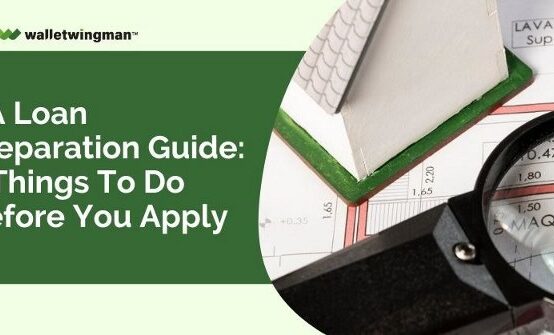In a previous article, we explored some of the things a home buyer with a VA loan can do if the appraisal comes in below the purchase price—one of those options involved what’s known as the Reconsideration of Value, or ROV.
This guide explains what a Reconsideration of Value is, how it can affect your VA loan appraisal, and the VA loan appraisal requirements to pursue the ROV option.
VA Loan Home Appraisals

If you use a VA loan to buy a house, the property will have to be appraised by a VA-approved home appraiser. The purpose is twofold: (1) to determine the value of the home and (2) to ensure it meets the minimum VA loan property requirements.
Sometimes, the appraisal will come in lower than the purchase price the buyer has agreed to pay. This is commonly referred to as an appraisal gap. This occurs when the appraiser determines that the house is worth less than the mutually agreed-upon purchase price.
If you find yourself in this situation when buying a home, you have several options to consider. According to the official VA loan home buyer’s guide issued by the Department of Veterans Affairs, you could pursue the following options:
- Request a Reconsideration of Value (ROV)
- Renegotiate the sale price to reflect the appraisal
- Bring cash to the closing table to cover the difference
- Use the VA loan “Escape Clause” to exit the deal without penalty
- Request a “cost-approach” appraisal on new construction
For the rest of this guide, we will focus on the first option presented above, the Reconsideration of Value for a VA loan home appraisal. Through this process, home buyers (and their lenders) can challenge the home appraisal and provide supporting data.
Reasons for Requesting a Reconsideration of Value

In some instances, borrowers may feel that the appraised value of the property is not an accurate reflection of its worth despite VA assessments being comprehensive and objective. Requests for a value reassessment are frequently made for the following reasons:
1. Discrepancies in Comparable Sales
Discrepancies in comparable sales are when the appraiser may have missed some information relevant to the subject property or used wrong or inaccurate information when assessing its value.
In this case, the market approach may be used to omit information about recent sales of comparable properties in the neighborhood that could better reflect the features of the subject property and might lead to its undervaluation.
These inconsistencies, in particular, can lead to inaccurate appraisals and, thus, a need to reconsider the value. The purpose is to take the property through a fair evaluation process proportional to its worth.
2. Unforeseen Property Features
Unforeseen property features are the property’s characteristics, discoveries, and renovations that the appraiser most likely needed to be made aware of during the VA appraisal checklist.
The inventories of such properties could go beyond the recent renovations, add-ons, or other upgrades that could have added a significant value to the property but could have been more accurately reflected in the appraisal.
In such cases, that can lead to the underestimation of the property. Through the emphasis made on unexamined facets and property valuation, borrowers can prove their case and hence get a proper appraisal outturn that has been taken into consideration and is related to the actual market value of the property.
3. Market Trends
The area known as the real estate market trends involves all the dynamic changes and the waves occurring within a defined place continuously assayed in the property value. Such movements illustrate variations around the supply-demand relationship, economy-related conditions, interest rates, and other factors co-determining the prices for real estate.
When non-negligible market fluctuations occur between the date of the initial appraisal and the loan application is completed, the appraised value may no longer be consistent with the current marketplace.
The lender will showcase these variations and provide the current market data for a request for reconsideration that explains why the property should be reevaluated by current market trends, which should end in a fair evaluation of its true worth.
4. Errors or Omissions
Inaccuracies, overlooked details, or missing data that might affect the value estimate of a property are referred to as errors or omissions in the appraisal process. These mistakes may include data input errors, missing important details that impact the property’s value, or failing to take into consideration pertinent property attributes.
The appraisal value may be erroneous as a result of these errors and not accurately reflect the property’s genuine market worth. Bosses may make a strong case for a reevaluation of value by pointing out and correcting these mistakes or omissions.
This will help to guarantee a just and accurate assessment result that is in line with the property’s true qualities and market conditions.
The Reconsideration of Value (ROV) Process

Here’s how the Department of Veterans Affairs explains the Reconsideration of Value that can be used during a VA loan purchase transaction:
“If you feel that the appraised value is less than it should be, ask your lender or real estate agent to provide valid sales data to your lender to support your opinion. VA staff will review the appraisal report, the additional data that was provided, and market data available in the VA Appraisal Management Service.”
If they agree that the home should have been appraised at a higher value, the loan process could move forward. On the other hand, if the VA decides that the original appraisal is accurate, the home buyer might have to pursue one of the different options outlined above.
Home buyers do not request an ROV directly from the Department of Veterans Affairs. Instead, a borrower using a VA loan must work with their mortgage lender to submit an inspection. However, the process has VA loan inspection requirements (assuming the lender agrees that it’s justified).
The process can vary based on the circumstances, but it usually works like this:
1. Review the Appraisal Report: The buyer obtains a copy of the appraisal report or the Notice of Value (NOV) and reviews it for errors, omissions, or under-valued aspects of the property.
2. Gather Supporting Evidence: The buyer collects data to support a higher valuation, if possible. This might include recent sales of comparable homes in the area, documentation of significant upgrades or renovations, and any VA certificate of eligibility error (e.g., incorrect square footage, outdated comps).
3. Contact the Lender: The buyer expresses concerns about the appraisal’s accuracy to their lender and presents the supporting evidence. Note: the buyer cannot directly request an ROV from the VA.
4. Lender Initiates ROV: The lender reviews the buyer’s concerns and evidence. If they decide it has merit, they’ll initiate the ROV process. The VA appraisal requirements consists “narrative outlining the perceived shortcomings of the VA appraisal along with an explanation regarding the reason(s) the information provided in the report is incorrect.”
5. SAR Review: For VA loans, a Staff Appraisal Reviewer (SAR) may examine the original appraisal, the revised information, and the appraiser’s response to determine if a new assessment is warranted.
After all of this, the appraiser will either adjust the original value that was offered based on the new information or maintain the original valuation.
Making a Realistic Purchase Offer

As you can see, this is a somewhat complex process with an uncertain outcome. So, the best-case scenario is to avoid it entirely.
Home buyers who use VA loans can reduce the chance of a low appraisal situation by making a realistic offer based on recent and comparable sales data. With this approach, you’re performing some due diligence upfront to make an offer that reflects current market conditions.
This kind of homework helps you avoid an appraisal gap altogether, which also eliminates the need for a Reconsideration of Value on a VA loan.
Real estate agents specialize in this kind of market research. So consider working with an experienced agent who understands the VA home loan process and knows how to make an intelligent offer backed by data.
You can also do some of this research on your own, thanks to the Internet. You can use property listing websites like Realtor.com and Trulia to view recent sale prices in the area where you plan to buy. This will help you make an intelligent offer based on comparable sales.
Tips for Success
The borrower must advocate for themselves and prepare carefully in order to navigate the reconsideration of value procedure successfully. In order to increase the probability of a successful outcome, consider these suggestions:
- Be In-detail: Try to bolster your case for reconsideration with as much pertinent data and documents as you can.
- Remain Composed: When speaking with your lender and any other individuals involved in the process, keep your composure and act professionally.
- Understand Your Legal Rights: To guarantee the protection of your rights as a borrower, familiarize yourself with the VA’s policies and procedures involving reconsideration requests and appraisals.
- Take Into Account Expert Assistance: It could be advantageous to get advice from a real estate expert with knowledge of VA loan transactions in complicated scenarios or circumstances where the risks are high.
In conclusion, Home buyers using VA loans can pursue a Reconsideration of Value if they feel that a low appraisal is unwarranted. The borrower must work through their mortgage lender to initiate the process, ideally providing some supporting information. However, the ideal scenario is to avoid this process entirely by making a realistic offer.


 How to Buy a Condo Unit with a VA Mortgage Loan
How to Buy a Condo Unit with a VA Mortgage Loan  How Credit Scores Affect Mortgage Rates on a VA Loan
How Credit Scores Affect Mortgage Rates on a VA Loan  How Much Can I Borrow When Using a VA Loan to Buy a House?
How Much Can I Borrow When Using a VA Loan to Buy a House?  The VA Cash-Out Refinancing Process Explained
The VA Cash-Out Refinancing Process Explained  10 Important Quotes from the Official VA Loan Buyer’s Guide
10 Important Quotes from the Official VA Loan Buyer’s Guide  VA Loan Preparation Guide: 7 Things to Do Before You Apply
VA Loan Preparation Guide: 7 Things to Do Before You Apply 